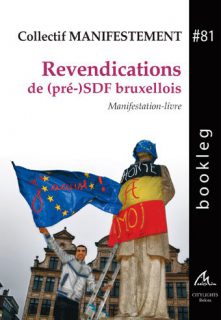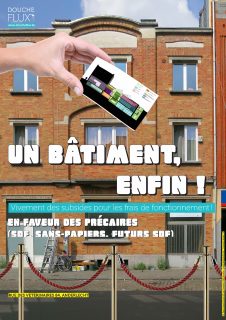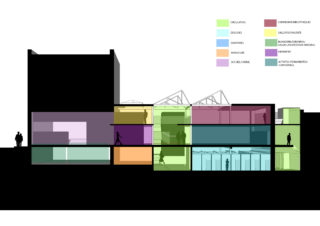Context
Historically, the population of the centre of Brussels has always included a large proportion of poor people, and this is still the case today. People from all over the country come to Brussels with the hope of finding new opportunities and a better life. The city also draws a lot of asylum seekers, both with and without papers. The situation in the capital of Europe is getting worse and is now quite alarming:
- The Brussels Region counts more than 5,300 homeless persons[1].
- There are an estimated 85,000 to 160,000 people without Belgian resident’s permit[2].
- 33% of the Brussels population lives with an income below the at-risk-of-poverty threshold[3].
- Almost one child out of four lives in a household without labour income[3].
The DoucheFLUX project

At the end of 2011, DoucheFLUX came about in the wake of a demonstration by the MANIFESTEMENT, organised for and with homeless people living in Brussels. During the preparation of the event, several unexpected and shocking realisations came to light:
- There are nowhere nearly enough showers, launderettes and lockers. The existing infrastructure is too expensive for many people facing extreme poverty, and their use is often subject to conditions that effectively exclude them.
- There is a shortage of meaningful and stimulating activities open to those living in precarious circumstances.
- There is no central, up-to-date source of information about social services available in Brussels.

With its recently renovated building on Rue des Vétérinaires in Anderlecht, DoucheFLUX aims to provide the best possible service in modern, pleasant, spacious, stimulating and user-friendly facilities.
The target population for DoucheFLUX extends far beyond the vulnerable people living in the immediate vicinity of Brussels’ South Station. DoucheFLUX sees itself as an association with a ‘low access threshold’, reducing the conditions imposed on users to the absolute minimum.
The DoucheFLUX project has been designed to complement the work of the various bodies active in the fight against poverty in Brussels. And we intend to encourage partnerships and synergies with individuals and organisations, whether from the social sector or other sectors.
Timeline
- 2009: First awareness of the problem
- 2010: Demonstration by the MANIFESTEMENT collective for and with homeless people living in Brussels
- 2011: Field analysis and setting up of the not-for-profit association; publication by Maelström of Revendications de (pré-)SDF bruxellois (Demands of homeless people (and those on the verge of becoming homeless) in Brussels)
- 2012: Start of activities

- 2013: Search for buildings, signature of the building purchase agreement
- 2014: Building purchase completed, building permit obtained, ImmoFLUX social cooperative set up, full-time staff member taken on
- 2015: Start of renovation works
- 2017: Official opening of the building, launch of services, recruitment of a team of salaried staff
- 2019: Official launch of Survivinginbrussels.be
- 2020: Opening of Transit Accommodation in a hostel/hotel due to the corona pandemic
The origins and development of DoucheFLUX have been told in the documentary Shower Power by Effi & Amir (2018).
_______________________